Planting and growing holly bushes is a great way to add beauty and color to your property during the dreary winter months.
There’s no denying that winter can bring about bleak and dull landscapes. Especially since that’s when most of the plants and trees lose their foliage for the season. However, not all bushes and plants drop their leaves in the fall.
The holly bush is one such plant. It is considered a deciduous or evergreen plant, which means that its foliage stays on all year long. It features glossy, thick leaves and seasonal bright red berries that can really stand out against a drab backdrop.
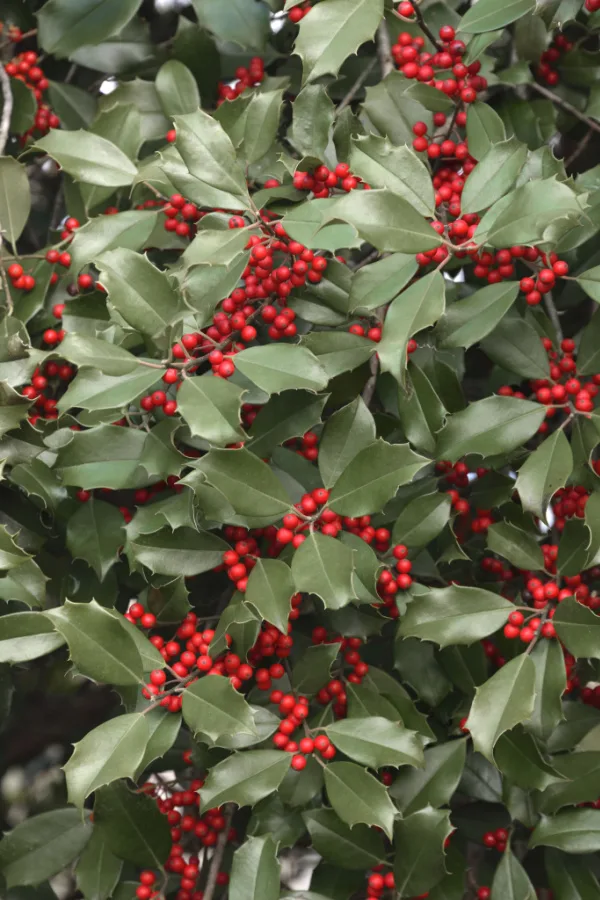
The American holly is actually often called Christmas Holly since it is regularly used in holiday decorations for making wreaths, swags, and garlands. The combination of bright green leaves and those pops of red can turn a drab landscape (or mantelpiece) into a festive display – No untangling of lights required! Combine its festive appeal with its low-maintenance and care, and it’s a great addition to any property!
Male & Female Plants
Holly is a type of dioecious plant, which means that it is each plant is either male or female. In order to produce those beautiful red berries, you will need both a female holly plant in addition to a male plant.
Only the females are able to produce the berries while the males produce the pollen. In order for the female’s buds to have bees and other insects pollinate it, there needs to be a male plant within 50 to 100 feet.
One male plant can pollinate up to five female bushes though. Just make sure they bloom at the same time for pollination to occur. While you can grow a single holly bush, you will not have the iconic berries if you only have one or the other.
If your female plant does produce berries, they can last anywhere between 3 to 6 months. This time frame will depend on the wildlife and birds in your location.
Varieties of Holly – Growing Holly Bushes
There are several different types of holly bushes available. Some can grow up to 50 feet tall with a spread of 20-40 feet at maturity. This makes them more tree-like than a real bush. Most average around 20 to 30 feet tall, however. There are some cultivators that can be as short as 2 feet tall, which makes them great for smaller areas.
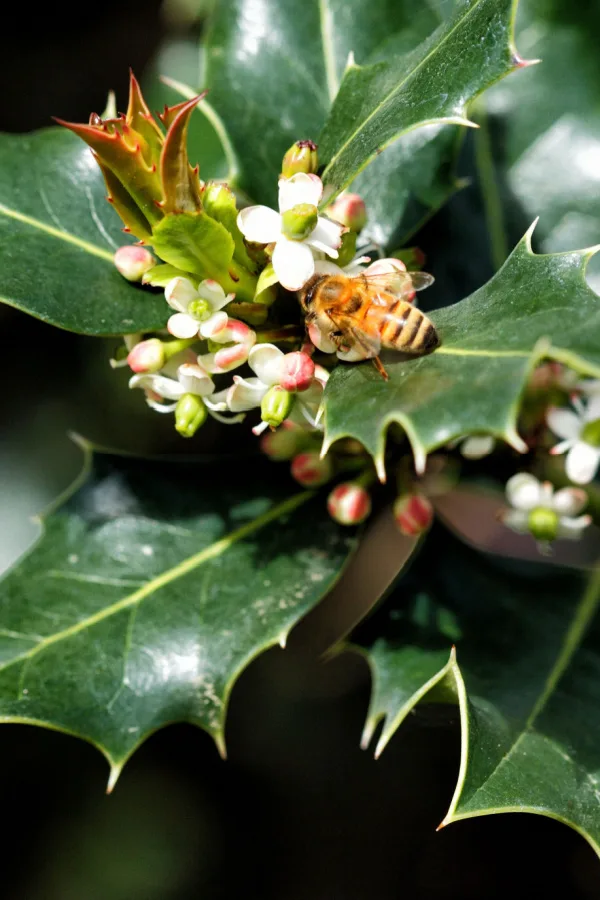
All holly bushes grow similarly to pine trees, with a thinner top that gradually gets wider toward the base of the plant (visualize a cone shape). If you prefer a different shape, holly bushes can be pruned to fit your aesthetics if maintained.
Their foliage features glossy leaves in shades of green, blue-green, variegated, or even gold-hued. The leaves range from around half an inch long all the way to several inches long.
Popular Male Varieties
‘Jersey Knight’ – This male cultivator is one of the more popular available with its dark, glossy foliage. It can reach heights of around 7 to 10 feet, but will eventually reach around 20 to 30 feet in about 10 years or so once it reaches maturity.
‘Cobalt’ – This male variety is excellent for colder regions since it is hardy down to -25º Fahrenheit (-32º Celsius). They end up on the taller side of holly bushes, with a mature height of around 40 to 50 feet tall.
Popular Female Varieties
‘Jersey Princess’ – This is a great female option to pair with the ‘Jersey Knight’. It is a heavy berry producer and features dark, glossy foliage. It grows to be around 20 to 30 feet tall.
‘Miss Courtney’ – A popular female cultivator that can withstand temperatures down to -20º Fahrenheit (-29º Celsius). It grows to be around 20 to 30 feet tall.
‘Goldie’ – This female variety is a heavy producer that makes yellow berries as opposed to red. It grows to be around 30 feet tall and 20 feet wide.
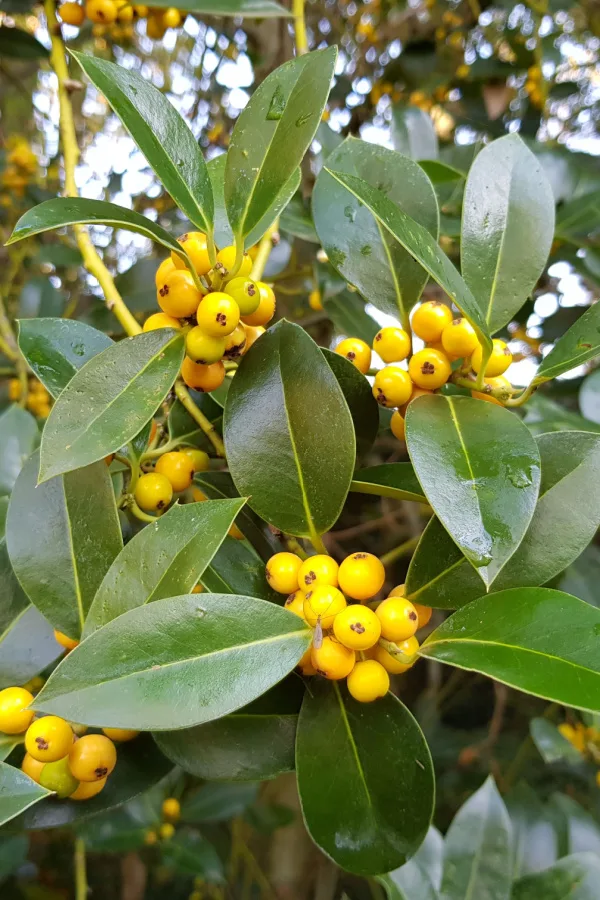
‘Maryland Dwarf’ – This dwarf American holly bush only grows to a height of around 2 to 3 feet tall but it can be up to 10 feet wide. It makes a perfect hedge or border shrub.
How To Plant, Grow, And Maintain Holly Bushes
Soil Requirements for Holly Bushes
While holly bushes can grow in a wide variety of soil types, they prefer loose, well-draining soils over dense soils like clay. In addition, they do not do well with highly alkalinic soils.
If your soil is alkalinic, you can add peat moss or pine needles to help try to lower the pH value. There are also acidic soil conditioners that contain aluminum sulfate that you can use as well. Aim for a pH balance of 6.0 or lower.
If your soil is heavy and dense, consider adding vermiculite or perlite to help loosen the soil. Adding in compost can also help with the overall composition of clay-like soils.
Planting American Holly Bushes
American holly bushes are hardy in Zones 5 through 9 and can handle lower winter temperatures. Most are grown from potted plants that you purchase at nurseries or garden centers. You can even find varieties for sale online, but make sure it’s a good cultivator for your particular location before purchasing.
The best time to plant holly bushes is in either in the fall, late winter if the ground is workable, or very early spring. This allows the roots to become established before the ground freezes or before the stress of summer heat hits.
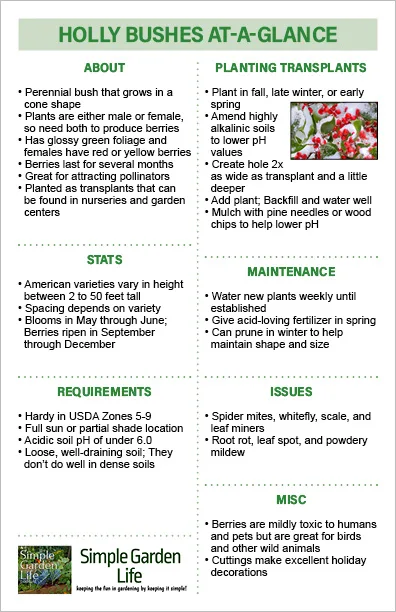
Choose a location that receives full or partial sun for best results. Overly shady locations will cause the bush not to grow as full and vibrant. It will also likely struggle to produce many blooms and berries.
Create a hole that is around two times the width of the plant’s current container and a little bit deeper. Amend the surrounding soil if needed before adding in the plant.
Place the plant in the hole, making sure that the top of the soil line matches up with the top of the plant’s rootball. You do not want the berry bush to be in a recess because you’ll have an issue with pooling water and root rot. Backfill and water well.
Long-Term Care – How To Grow and Maintain Holly Bushes
Thankfully, once they become established, holly bushes are relatively easy to care for and maintain. They will grow around one to two feet a year until they have reached their final mature height (this will vary based on the cultivar).
Holly bushes typically bloom in the months of May through June, but the blooms themselves aren’t really that stunning. However, they are great for attracting all sorts of pollinators to your property. The berries on female bushes ripen between September and December and will last for several months.
Watering
When plants are newly planted, water them weekly. Continue to do so for the first few months. After plants are established, normal rainfall should be enough to keep holly plants thriving and happy. Only water in cases of extreme drought once established.
Mulching
Adding mulch after planting can help the berry bush to regulate soil temperatures and help retain moisture in the summer months. If your soil is highly alkalinic, use pine needles or wood chips as your mulch to help lower the pH.
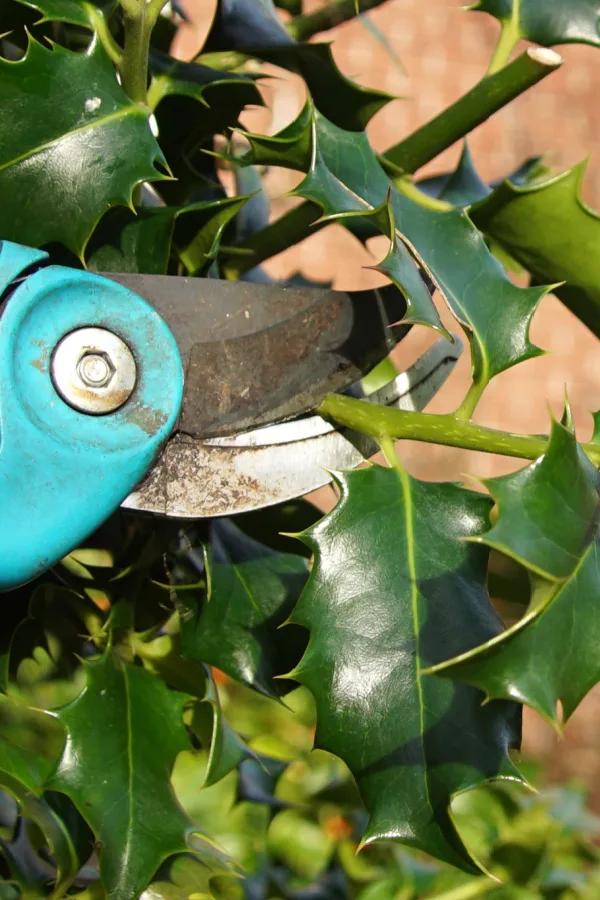
Fertilizing
Once spring rolls around, apply a fertilizer that is geared toward acid-loving plants and bushes. Avoid fertilizing in the fall since this can cause the bush to produce new growth that can become damaged easily with colder temperatures and elements of winter.
Pruning
While it isn’t required, you can prune your holly bushes to keep them in your desired shape and from growing too tall. Do not prune in the spring and summer while plants are actively growing. This can cause plants to go into stress and will reduce the number of blooms and berries.
Instead, prune in the middle of winter while plants are dormant. A bonus to pruning during this time is that the branches you trim can be used for creating natural holiday decorations.
Remove any damaged or dead branches while pruning. If you need to heavily prune the holly bush, be sure not to remove more than a third of the plant at a time.
Keep in mind that there are some bushes and shrubs that you shouldn’t trim in the fall and winter months. To find out what more about those plants, check out “6 Bushes & Shrubs To Avoid Pruning In The Fall.”
Pests & Issues
Overall, holly bushes are fairly problem free. However, as with any plant or shrub, they are susceptible to a few pests and diseases. The most common pests are spider mites, whitefly, scale, and leaf miners.

Root rot, leaf spot, and powdery mildew are the biggest issues when it comes to diseases. Some varieties are better at being deer resistant than others, so keep that in mind when choosing your variety.
Word Of Warning
Be aware that while the bright red berries might be tempting, they are not for human consumption. They are slightly toxic to humans as well as pets if they are ingested. Thankfully, the berries are a perfect treat for several different birds and wildlife like bluebirds, cardinals, wild turkeys, and other songbirds.
They are also perfect for creating those beautiful holiday decorations that are so iconic during the winter months. Pair them with your Christmas cactus and poinsettias for a really stunning, 100% natural holiday display.
By following these simple tips for planting and growing holly bushes, you can enjoy their beautiful foliage and pops of color all year long!
Follow Our Facebook Page For Even More Great Tips! Simple Garden Life Facebook Page
Simple Garden Life is a website dedicated to keeping gardening fun, simple and enjoyable! We publish two new articles each week along with a new garden podcast episode every two weeks. This article may contain affiliate links.
Feel free to download, print out, or save our Holly Bush At-A-Glance sheet. It is sized for half-letter printing but can be scaled if needed.
